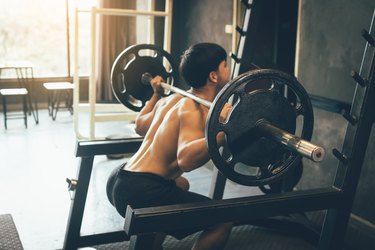
When it comes to fitness goals, everyone has a thing they're going for. For some, it's nice legs. For others, it's a sculpted core. But for men and women alike, there's just something about having bigger glutes.
Having a nice butt is always a plus, but a perky posterior also means better performance. In fact, the glutes — the largest muscle group in the body — are arguably the most important muscles to train.
Video of the Day
Video of the Day
"From hip explosion power to hip and lower extremity stabilization, strong glutes are a must," Austin Lopez, a certified sports and conditioning specialist and trainer at Diakadi in San Francisco, tells LIVESTRONG.com.
With consistent weight-training workouts designed to build muscle, you will see significant development in the size of your glutes. But bulking up your derriere takes more than just doing supersets of lunges, squats and deadlifts.
Here, Lopez shares the best training strategies for bigger glutes — including reps and sets — and offers a glute workout to kick things off.
What Are the Glute Muscles?
Your glutes are made up of three major muscles: the gluteus maximus, medius and minimus. Together, these muscles serve as hip rotators, hip extensors and lateral abductors (moving the leg away from the middle of your body), according to the American Council on Exercise (ACE).
- The gluteus maximus — the largest muscle of the three — plays a number of roles in your everyday movement and stability. It works mainly to extend and laterally rotate the hip.
- The gluteus medius lies underneath the gluteus maximus and moves the leg away from the midline (think: fire hydrants and clamshells).
- The gluteus minimus — the smallest, fan-shaped glute muscle — also abducts the leg away from the midline and helps stabilize the pelvis.
When people think of building a bigger butt, they tend to focus only on their gluteus maximus, but if you want a rounder behind, you should give your gluteus medius and minimus equal attention.
"Certain training, like jumps, are heavily gluteus maximus-focused, but do require the recruitment of the entire muscle group," Lopez says. "The smaller glute muscles really come into play when balancing. Both the medius and minimus require a bit more of a focused approach, often requiring some special pieces of equipment — like steps, resistance bands or a BOSU ball — to isolate them."
Related Reading
The Benefits of Stronger, Bigger Glutes
Strong glutes are a critical component of accelerating, decelerating and moving in different directions.
When all three muscles of the glutes are fired up, they produce great power to perform basic tasks and athletic activities, such as carrying groceries up a flight of stairs, jumping to throw a lay-up in a basketball game and running a marathon.
Bigger glutes can also reduce your overall risk of injury, from your hips to your groin, and decrease the incidence of lower back pain, according to the ACE. When you have weak glutes, your hip flexors compensate, which can lead to compression of the lower spine.
But by strengthening your glutes, you relieve some of that pressure and decrease your chances of back injuries in popular weighted butt exercises, like deadlifts and back squats.
Related Reading
How to Build Glute Workouts for Mass
Before you start lifting the big weights, it's important to ensure that that you have the proper mobility, Lopez says. "Big glutes can only get you so far if you can't move through a good range of motion," he says.
Mobility moves like hips CARS (controlled articular rotations) and side-to-side leg swings are a great way to improve your range of motion and warm up before your workout.
When it comes to load, Lopez recommends that most people use moderately heavy weights paired with slow eccentric movements for an increase in muscle size. For example, slow down the tempo with your squats and lunges during the downward phase. By increasing the time your muscle is under tension, you recruit more muscle fibers, which helps with promoting muscle definition and growth.
According to the ACE, the best recipe for hypertrophy — the process of growing muscle size — is 6 to 12 reps at 67 to 85 percent of your one-rep maximum, aka the heaviest weight you can lift at once for any given exercise. (You'll do fewer reps the closer you get to 85 percent of your one-rep max.)
In other words, if you can do a single deadlift at 100 pounds, then scaling down to two 35-pound dumbbells is a great place to start.
But banging out a bunch of squats every day won't get you on the fast track to a bigger butt. To grow larger glutes, Lopez suggests working them out only three days per week. This gives you plenty of time to focus on other muscle groups and incorporate some cardio workouts into your routine.
How long it takes you to notice improvements depends on a number of factors, including your sex, hormone levels and training history. But generally speaking, you should start to see visible changes in muscle size in six to 10 weeks.
As the weeks go on, you should increase the amount of weight you're lifting to continue getting stronger and growing bigger muscles. Aim to increase the weight, reps, tempo and intensity of your exercises every six to eight weeks, according to the principle of progressive overload.
So, if you can do 12 goblet squats with no problems, switch to a more challenging weight that you can use to complete 5 to 8 reps with proper form. Check in with yourself every few weeks and continue to gradually add weight to see results.
And remember, rest is your friend. Intense lifting causes microscopic tears to form in the fibers and connective tissues of muscles, according to the Cleveland Clinic. Your body needs time to repair these tears, and it's during this process that muscular growth really happens.
According to the ACE, the perfect training schedule for hypertrophy includes 24 to 72 hours of rest before you work out the same muscle group again. This allows you to get in at least two butt workouts per week, such as on Tuesdays and Fridays. On your recovery days, consider doing some light stretches, foam rolling and other mobility drills to help relieve soreness and tightness.
What to Eat for Bigger Glutes
In addition to training, Lopez stresses the importance of thoughtfully planning out your meals for hypertrophy. "Like any muscle, the glutes need good food to get bigger," he says. "Think of complete, balanced nutrition with at least a light surplus."
Although you can build lean muscle mass with a calorie deficit, limiting calories is not ideal for hypertrophy. In fact, a small surplus of calories is going to give your muscles the extra nutrients and energy they need to get bigger and stronger.
Lopez recommends eating more carbs and protein on the days you work out, and on recovery days, adding a 100- to 200-calorie surplus to help build muscle and reduce unnecessary fat gain. Carbs and protein are particularly important to consume post-workout to help repair your muscles.
Fueling up on carbohydrates will help restore your glycogen stores for the next workout. As the building block of muscle tissue, protein contains essential and non-essential amino acids. Your body produces non-essential amino acids, but you get essential amino acids from your diet.
The amino acid leucine, for example, is part of a group of branched chain amino acids (BCAAs), which are a special subset of amino acids critical for muscle growth. (You might have noticed some protein powders hyping up their BCAA content.)
The easiest way to ensure you get essential and non-essential amino acids in your diet is to add a variety of protein in your meals. Eating lean cuts of meat, poultry, eggs, dairy, fish and beans and legumes will give you a complete amino acid profile that's ideal for building muscle.
The ideal protein intake for muscle building is up to 1.6 grams of protein per kilogram of body weight, according to a July 2017 systematic review in the British Journal of Sports Medicine.
For example, if you weigh 155 pounds, you would convert your weight into kilograms by dividing it by 2.2. Then, you would multiply that number by 1.6, so you should be consuming around 113 grams of protein daily, or 38 grams per meal.
5 of the Best Glute Exercises
Ready to build a bigger booty? Below, Lopez shares some of the best butt exercises for every fitness level. (Bonus: They mimic real-life functional movements.) Do the workout once through as prescribed.
Move 1: Single-Leg Running Jumps
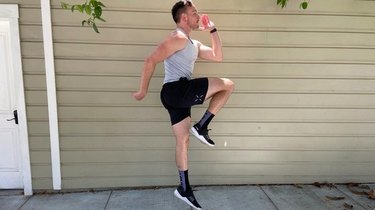
- Start in a runner's lunge, forming a 90-degree angle with your front knee. Keep your knee stacked over your front ankle and leave your back leg straight (or you can have a soft bend in the knee).
- Shifting your weight to your front heel, drive your back knee toward your chest with the back foot flexed and explode upward.
- Land softly and return to the starting lunge position.
- Repeat on the opposite side.
- Complete 6 reps on each side for one set.
Move 2: Dumbbell Glute Bridge
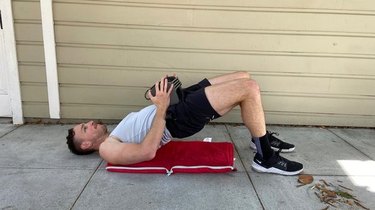
- Lie face up on a mat or the floor with your knees bent and your feet hip-width apart, toes turned out slightly. Hold a dumbbell with both hands and rest it between your bellybutton and hip bones.
- Keep your shoulders on the floor to help maintain a neutral spine throughout the movement.
- Press into your heels to lift your hips off the mat until your spine is straight, tucking your pelvis under slightly and squeezing your glutes. Your body should form a 45-degree angle from the top of your knees to your shoulders. Be careful not to hyperextend the low back.
- Hold this position for two seconds, keeping the glutes engaged.
- Slowly lower back to the starting position.
Tip
If your toes are facing forward, you'll be relying more on your hamstrings.
Move 3: Leg Raise From Side Plank
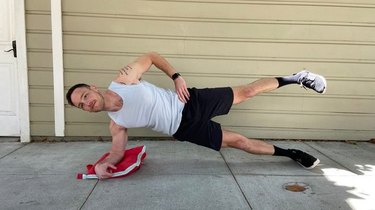
- Lie on your side and bring your forearm to the ground, stacking your hips and legs. Press up onto your hand in a side plank. Align your shoulder over your elbow and keep your hips square. This is your starting position.
- While holding this position, lift your top leg up toward the ceiling as high as you can without losing your balance.
- Lower your leg down for one rep.
- Complete 10 reps on each side.
Move 4: Goblet Lateral Lunge
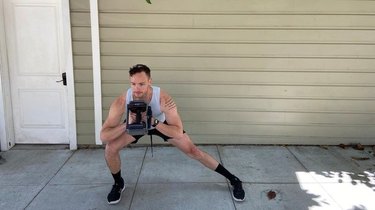
- Start standing with your feet together holding a single dumbbell with both hands at chest height.
- Take a big step out to the right. Sit into your right hip and straighten your left leg. Keep your left foot firmly planted on the ground with your feet parallel. Stick your butt back and transfer your weight into the heel of your right foot.
- Press into your right heel to stand back up and return to the starting position.
- Complete 10 reps on each side for one set.
Move 5: Alternating Dumbbell Reverse Lunge
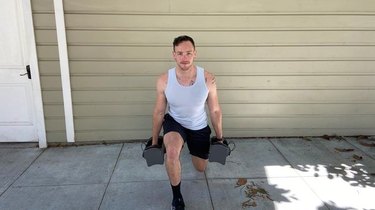
- Stand with your feet together with your arms at your sides, holding a dumbbell in each hand with your palms facing in.
- Keeping your chest up, take a big step back with your right leg and bend at the knees until your front and back legs form 90-degree angles. Your front thigh should be parallel to the ground, and your back knee should be hovering an inch above the ground, heels and toes aligned.
- Press through your left foot to straighten your leg and pull your right leg forward to the starting position.
- Complete 8 reps on each side for one set.
- American Council on Exercise: What Exercises Should I Perform if I'm Trying to Gain Weight?
- American Council on Exercise: "How to Select the Right Intensity and Repetitions for Your Clients"
- Cleveland Clinic: "Strenuous Workouts: Try These 6 Best Recovery Tips"
- American Council on Exercise: "Build Your Glutes With This Strength Training Routine"
- British Journal of Sports Medicine: "A Systematic Review, Meta-Analysis and Meta-Regression of the Effect of Protein Supplementation on Resistance Training-Induced Gains in Muscle Mass and Strength in Healthy Adults"
- American Council on Exercise: "How to Select the Right Rest Intervals and Post-Training Recovery for Your Clients"
Was this article helpful?
150 Characters Max
0/150
Thank you for sharing!
Thank you for your feedback!